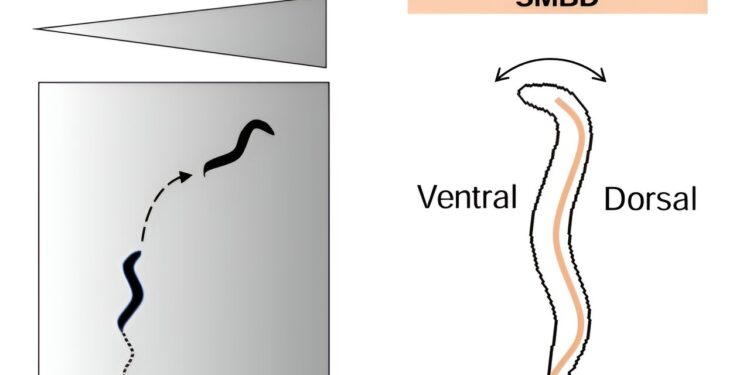Illustration of C. elegans bending toward regions with higher salt concentrations (left). Illustration of C. elegans and its dorsal (neck) motor neuron, SMBD (right). Credit: Matsumoto et al 2024
Joint research by Ayaka Matsumoto and Yuichi Iino of the University of Tokyo demonstrates that a temporal decrease in salt concentration leads to activation of the neck motor neuron of roundworms, but only in a specific phase of its activity.
Activation adjusts the roundworm’s trajectory toward higher salt concentrations. The discovery identifies the neural mechanism by which roundworms integrate sensory and motor information, a first step toward understanding the neural mechanisms of navigation in more complex animals. The results were published in the journal Proceedings of the National Academy of Sciences.
It took thousands of years of concentrated effort for human civilization to build (somewhat) autonomous vehicles. Yet even the simplest animals can integrate sensory information about their environment and adjust their movements accordingly. As such, the integration of sensory information and motor control is one of the most fundamental questions a biologist can address.
This is precisely what the research team decided to do using a species of roundworm called Caenorhabditis elegans. All 302 C. elegans neurons are fully mapped, allowing the effects of a single neuron to be manipulated and observed.
“Roundworms move by slowly curving toward regions with higher salt concentrations,” says Matsumoto, the paper’s first author. “To control this bending behavior, roundworms must detect salt concentrations perpendicular to the path of their movements. However, they only have a single ‘sensor,’ which prevents them from detecting salt concentrations in space. Therefore, roundworms must detect salt concentrations perpendicular to the trajectory of their movements. must process temporal changes in salt concentrations to recognize the preferred side.
To study this hypothesis, the team used a “swivel head chip,” a small device that allows the worms to move their heads freely. Next, the researchers observed how the animals “locked” in this apparatus reacted to increasing or decreasing salt concentrations.
Roundworms move by contracting the muscles that run along the longest axis of their body. As a result, their head swings back and forth between the direction of their stomach (ventral side) and that of their back (dorsal side), eventually curving more toward the direction they intend to go.
Here, the researchers found that decreasing salt concentrations activated the dorsal neck SMBD neuron only in a specific phase of its activity, and that its activity was strongly correlated with neck swings. Activation of the SMBD in response to a decrease in salt concentration corresponded to the moment when the neck curved towards the ventral side. This suggests that the SMBD detects the lowest salt concentrations on the ventral side of the body.
Furthermore, the team revealed that artificial activation of the SMBD during ventral neck flexion made subsequent ventral neck flexion shallower. Combining their results, the team inferred that SMBD plays a role not only in detecting changes in salt concentrations, but also in suppressing neck flexion toward the side with lower concentrations. It thus directs the worm towards higher salt concentrations.
“Even though we found that the SMBD neuron integrates sensory and motor information, the molecular mechanisms of integration remain unknown,” says Matsumoto, highlighting future research.
“Therefore, we are interested in what happens inside the SMBD neuron when it detects changes in salt concentration and neck movements. We would also like to observe the activity of all neurons in the brain at the same time. time during navigation.”
More information:
Neural sensorimotor integration guiding navigation in salt concentration in Caenorhabditis elegans, Proceedings of the National Academy of Sciences (2024). DOI: 10.1073/pnas.2310735121. doi.org/10.1073/pnas.2310735121
Provided by the University of Tokyo
Quote: Follow the salt: linking salt concentrations and movement in roundworms (January 22, 2024) retrieved January 22, 2024 from
This document is subject to copyright. Apart from fair use for private study or research purposes, no part may be reproduced without written permission. The content is provided for information only.



